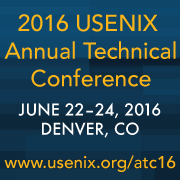sponsors
help promote
usenix conference policies
Beam: Ending Monolithic Applications for Connected Devices
Chenguang Shen, University of California, Los Angeles; Rayman Preet Singh, Samsung Research; Amar Phanishayee, Aman Kansal, and Ratul Mahajan, Microsoft Research
The proliferation of connected sensing devices (or Internet of Things) can in theory enable a range of applications that make rich inferences about users and their environment. But in practice developing such applications today is arduous because they must implement all data sensing and inference logic, even as devices move or are temporarily disconnected. We develop Beam, a framework that simplifies IoT applications by letting them specify “what should be sensed or inferred,” without worrying about “how it is sensed or inferred.” Beam introduces the key abstraction of an inference graph to decouple applications from the mechanics of sensing and drawing inferences. The inference graph allows Beam to address three important challenges: (1) device selection in heterogeneous environments, (2) efficient resource usage, and (3) handling device disconnections. Using Beam we develop two diverse applications that use several different types of devices and show that their implementations required up to 12x fewer source lines of code while resulting in up to 3x higher inference accuracy.
Open Access Media
USENIX is committed to Open Access to the research presented at our events. Papers and proceedings are freely available to everyone once the event begins. Any video, audio, and/or slides that are posted after the event are also free and open to everyone. Support USENIX and our commitment to Open Access.
author = {Chenguang Shen and Rayman Preet Singh and Amar Phanishayee and Aman Kansal and Ratul Mahajan},
title = {Beam: Ending Monolithic Applications for Connected Devices},
booktitle = {2016 USENIX Annual Technical Conference (USENIX ATC 16)},
year = {2016},
isbn = {978-1-931971-30-0},
address = {Denver, CO},
pages = {143--157},
url = {https://www.usenix.org/conference/atc16/technical-sessions/presentation/shen},
publisher = {USENIX Association},
month = jun
}























connect with us